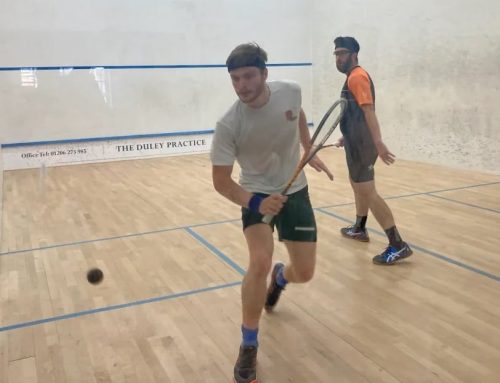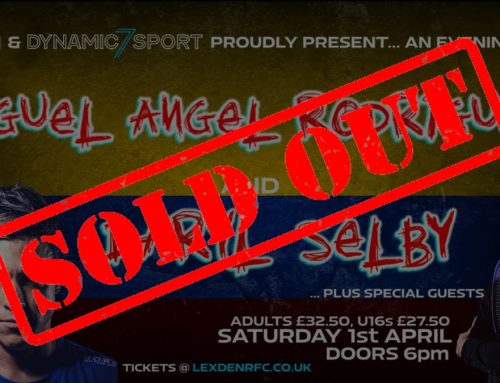The serve and the return of serve are two of the most important shots in the game of squash, their roles are vital. Come to think of it, this probably also applies to many other racket sports. I am no expert other disciplines but I should imagine a tennis coach, badminton coach and table tennis coach would all say the same regarding the serve and return in their own chosen field.
So what makes a good serve? And what makes a good return of serve? Well, the short answer in both cases is ‘one that has a positive effect on your rally’. Therefore, a bad serve or return is one that has a negative effect on your rally!
The serve
This is pretty much the most closed skill in squash, a shot with very few variables. You don’t have to run or lunge to reach the ball; you don’t have to cope with the ball being tight against the wall or close to the back corners; or coming at you from a height, or low at great speed and you will never have to deal with any unexpected dodgy ricochets’ or bounces!
This means when serving we have a fantastic opportunity to instantly put our opponent under huge amounts of technical pressure by delivering the best possible serve we can.
When working on the serve in group or one to one sessions I am keen to highlight three key ingredients that each serve must contain. These are width; length and T position.
Width
When serving we must aim to get the ball past our opponent, stop them attacking, push them back, make them defend off the back foot from deep in the court. Hitting good width by aiming for the sidewall on our serve will help with this objective. Before you serve look at your opponent, note where they have chosen to stand then pick your spot on the sidewall. The ideal spot to aim for on the sidewall is in line with your opponents waiting position, hitting the side wall earlier than that will allow them to simply rotate and let the ball rebound off the sidewall directly into their swing path. Alternatively, if you aim to hit the sidewall to deep they will step in and cut it out on the volley before it even gets there!
Length
A serve that lands short will get punished! If you have managed to stop your opponent volleying through good width, make sure the ball has enough pace; height and trajectory to have its first bounce close to the backwall. If your opponent is made to deal with the backwall impeding their swing they will be forced into boasting or flicking the ball straight with no pace. Be careful not to over hit the serve, a ball that comes off of the backwall on the full is pretty easy to deal with and will encourage your opponent to attack and get on the front foot.
The ‘T’
As mentioned in my previous article ‘tactics’ one of the key strategies within the game of squash is to win the T and then hold on to it. The server has a great opportunity to instantly do as such.
To be economical, use your service momentum to naturally carry you through to the T. If you can do this successfully you will have time to set yourself to prepare and await your opponent’s response. You do not want to still be moving to the T when your opponent plays their return, if this happens you will be susceptible to being sent the wrong direction. A canny returner will take advantage of this by putting the ball to the opposite side of the court to which your movement is heading. Leaving you under immediate pressure to quickly alter your momentum, change direction and recover the situation.
Before moving on it is worth mentioning at this point that unlike the pro’s after serving us mere mortals should be looking to set ourselves around half a metre to a metre behind the T. This will realistically give us the best opportunity to cover our opponents returns played to either the front or back of the court. Professional players may look to push a little closer to the T because they can!
Types of serve
There are many kinds of serve you can adopt and try to perfect, whichever is your preference be sure to achieve the three key ingredients width, length and T position. It is well worth having a couple of different styles of serve in your locker in order to ‘mix it up’. Some opponents may be stronger or weaker at returning certain styles of serve, or their returns actually improve as the match goes on as they begin to settle and get used to your serve. If you spot this within a match it may be worth tactically making a change by using a different style of serve. A tactical change like this could help swing the momentum of the match back in your favour.
‘Standard’ Forehand serve
Many club players prefer the forehand serve (from both boxes) as opposed to the backhand serve as they find it technically easier to execute. When I refer to this style as ‘standard’ I am referring to the serve as having ‘standard’ average height and ‘standard’ average pace. This is a safe and consistent serve used by many, never really in any danger of error such as hitting under the service line or above the out of court line on either the front wall or side wall. Remember, with PAR scoring now in the modern game a foul serve immediately gifts your opponent a point.
Although there is neither; great height or power within this style of serve to trouble your opponent, if the width and length are accurate it can still give you a good solid start to the rally.
‘Standard’ backhand serve (from the forehand box)
Again a serve of average height and pace but this time executed from a players forehand service box using their backhand. You will have seen this serve used before, as it is favoured by advanced club players and professionals, it has many benefits: It is safe from error and consistently accurate. An advanced player will also have no technical issues with using their backhand for a serve.
If you use your backhand to serve from your forehand box you can see the side wall you are aiming for and your opponent all in your periphery vision, when serving forehand from the forehand box you have your back to your opponent and can see nothing.
When considering movement the backhand serve is very economical. As you step into your backhand serve and away from your service box your momentum is naturally taking you towards the T virtually in one step.
Finally, a backhand serve from the forehand box allows you a better angle onto the sidewall. When the ball makes contact with the sidewall from this style of serve the angle that it comes off is much sharper and more difficult to deal with for your opponent. If executed with a good amount of slice the ball can sometimes really skid and zip off the wall adding to your opponent’s woes.
Power serve
This serve is very effective at lower levels of the game and adopted by a few club players that have figured this out for themselves.
This style of serve has to be struck with a great amount of pace and to keep the length effective also has to be hit very low, approximately within a foot of the service line. The risk is gifting your opponent the point by accidentally hitting onto or below the service line for a fowl serve. However, the reward is that lower level players find returning this serve very difficult and it may take some months before they reach a level where they can cope. The pace of the ball travelling at such speeds results in them having very little time to pick up the flight of the ball and make the necessary quick adjustments in order to return adequately. If they manage to return at all, the ball will often just be popped up loosely to the middle of the court for the server to easily dispatch.
This low hard serve rapidly loses its effect with opponents at higher levels as more experienced players see the ball earlier. They can make decisions and adjustments quickly and can use the pace of the serve to angle away winners with ease, likened to a quality cricket batsman facing a fast bowler. The added problem here is also that the pace of the serve leaves the server with no time to get settled at the T, making retrieving accurate returns physically very difficult.
Lob serve
If practiced and perfected the lob serve can be one of the most effective shots in the game. However, it does have its downsides.
The lob serve utilises the very top of the front wall and is played with a careful judgement of pace and accuracy. The sever is trying to get the height, angle and weight of shot to descend into their opponents back corner, dropping just under the sidewall out of court line and hopefully dying out near the back corner.
Usually the lob serve is played to an opponent’s backhand, as even up to an advanced level they are more likely to struggle technically with the overhead volley on this side. The lob serve is most effective on colder courts, with high ceilings.
The downside of the lob serve is it flirts with touching the front wall out of court line, the ceiling and the sidewall out of court line, all of which would gift your opponent a point. The added danger here is that to avoid this happening you may end up playing the lob serve a little too conservatively and in doing so it will lack the height, width and depth it requires to be effective and a poor weak lob serve will be easily dispatched at virtually any level.
Body serve
This is a serve deliberately aimed down the centre of the court towards your opponent’s body or down their unorthodox side. This serve can be played from either box but is only effective as a surprise so use it sparingly. The idea is that the returner fails to react and adjust quickly enough and the ball either makes contact with their body gifting you the point or their slow reaction to adjust accordingly produces a weak return or error. Many players (myself included) choose not to adopt this serve at all due to danger of being possibly hit with the ball. The surprise and the lack of time to adjust can often result in the returner instinctively hitting the ball directly back at you. If you do like to occasionally throw in this serve I suggest wearing squash goggles!
The Return of serve
In my opinion this is the most difficult shot in the game! Player’s serves progress much quicker than their returns of serve, so for a while two competing players may struggle to even get a rally going. The server continues to rack up point after point building a healthy lead through either an ace or three shot squash (serve – poor return – winner). So how do we stop the rot and prevent this continuous losing cycle? We improve our return of serve.
The return of serve (primarily backhand) is the most frequently requested lesson by club players, and rightly so. There is no substitute for practice when it comes to the return of serve. Whether solo practice, pairs practice, or lessons with a coach, only through repetition and time will you gain the experience required to return well.
The downside of using your matches for return of serve practice is it is not enough repetition. If you lost the game you may have faced around 33-50 serves (and even less if you won). Only half of those returns may have been on your backhand which is usually the side that needs the most work. So let us say on average you execute approximately twenty backhand returns a match and you play once or twice a week, that’s not a lot of repetition. It will take years to practice the numbers of backhand returns required to reach an adequate level.
There are several tasks that have to be completed in order to consistently return well and they all take place within the space of a second!
To begin with get your starting position correct, players that have not come through a coaching program or been taught correctly by a fellow player may have evolved into their own slightly more unorthodox ready position. This will no doubt be effective at times as it is something you may have done for a while and through repetition you have perfected it. However, I can almost guarantee an unorthodox starting position is only effective against particular opponents with particular styles of serves. The ready position we teach allows you to be equally effective against any opponent with any style of serve.
I remember when I first entered the club leagues myself as a junior, I can’t quite recall the exact age, there are still one or two members around at the club who may be able to remind me. My dad was a pretty hard taskmaster, he insisted the coach at the time enter me into the very bottom division and make me work my way up month by month, despite already being at a level several divisions higher. I remember being frustrated by this at the time, but little did I know my dad was a ‘coaching genius!’ Working my way up through the lower divisions helped provide me with the experience and knowledge required to compete against opponents with various styles of serves and returns correct or unorthodox (mostly unorthodox).
Stand approximately in the centre of your back quarter just off the corner of the service box towards the middle of the court. Have your feet shoulder with apart facing the front wall, yes the front wall and not side wall. Before the serve is hit we want to be open, we will begin to rotate and become side on shortly. Unlike a badminton player, at this point be relaxed and have your racket low, we will lift the racket up into position when we rotate.
Whilst waiting for the serve watch the ball not the wall, do not take your eyes off of the ball. Even watch any bounces the server may have in their serving ritual. Watch the ball toss and the downswing towards the ball, as they begin swinging down you should start to swing up, lifting your racket up towards its ready position. When drawing back the racket we can also begin to rotate ourselves towards being more side on, all the time tracking the ball with your eyes from the server’s racket as it makes its way towards the front wall. Rotating and taking the racket back into its ready position nice and early means there will be less still to do when the ball is upon us.
At the earliest opportunity possible you have to make your assessments, predict in your mind where the ball is heading, this is known as ‘reading the ball’. Ask yourself what height, pace and angle is the ball travelling? Your reading of the serve, assessments and predictions will then determine your decisions and any minor positional adjustments you may need to make in order to be in a good hitting position. Do you step in and take it early before the serve hits the side wall or is the width to good? If it is then you need to back away and create space to hit the ball after the side wall. Reading the flight of the ball and moving your feet to make the necessary minor adjustments to your hitting position is vital and will probably be the difference between the return being a positive or a negative one.
You should always be looking to volley your returns when possible. Try to cut out your opponents serve before it reaches the back wall and potentially becomes even more difficult, unless of course the serve is under hit or over hit and coming off of the backwall on the full, then by all means leave it and take the easier option.
Based on your assessment of the serve, you need to make a decision on whether you hit an attacking or defensive return. Attacking doesn’t always mean going short to the front of the court it can also mean an aggressive hard hit length. If you have elected to defend and hit the ball deep to get in front of your opponent and therefore take control of the T, your return shouldn’t have too much pace but should have a lot of height and control. If the width and length on your return is good and makes it past your opponent, it will send them deep into the rear of the court. Allowing you to take control of the T and considerably increase your percentages of winning the rally.
Of course, you don’t always have to play the percentages, although you probably should if the score line is a bit tight. Always be alert and on the lookout for a poor serve, if the time is right and the serve is weak go for it, there is nothing better than an quick easy winner, a point without having to expend energy, but use this tactic wisely. A surprise return winner to the front is no longer a surprise if you play it every other shot! Personally I work on these rough percentages in my own matches. I look to return long and take control of the T around 70% of the time and I would probably hit most of these lengths straight with the occasional cross court. The remaining 30% is the surprise attacking short shorts, the aggressive quick short winner off of a weak loose serve or sometimes off of a good serve for even greater surprise, but appreciate the risk is high. Players lacking the technical ability to hit deep or have inadequate levels of fitness may have a higher percentage of short return winner attempts, but they probably also have a very high total of errors in their matches.
So how do you get your percentages of long and short returns to a less risky number, something resembling 70%-30% opposed to 50%-50%? If it is due to lacking the technical ability to return deep then get practicing, solo, pairs practice or lessons will help. Repeat volleying the ball high and deep over and over again, it will be a great investment to your game. If you are going short off of the return of serve to often due to being fatigued, work on your fitness and conditioning. Finally, if you are both technically capable and have good fitness but are still going short too often then work on your discipline!!!





